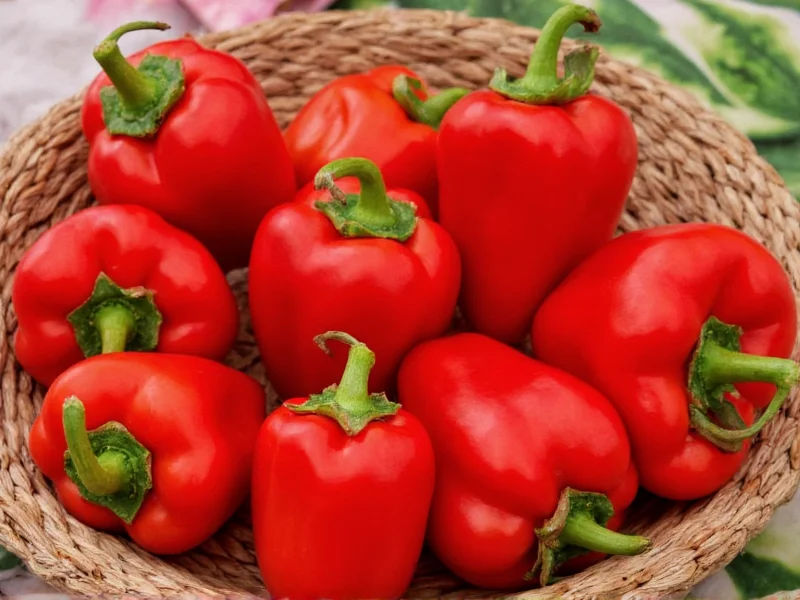A Scotch bonnet pepper (Capsicum chinense) belongs to the same species as the habanero but features a uniquely squat, rounded shape resembling a Scottish tam-o'-shanter cap—hence its name. This vibrant chili starts green and matures to brilliant shades of red, orange, yellow, or even chocolate brown, depending on the variety. Unlike many hot peppers that deliver one-dimensional heat, Scotch bonnets offer a nuanced flavor profile with tropical fruit notes of apricot, apple, and citrus that complement their fiery kick.
Physical Characteristics and Heat Profile
Measuring approximately 1.5–2 inches wide, Scotch bonnets have deeply furrowed, crinkled skin that distinguishes them from the smoother habanero. Their heat intensity places them firmly in the superhot category, though actual spiciness varies significantly based on growing conditions, soil composition, and maturity. While both Scotch bonnets and habaneros share similar Scoville ranges, many chefs note that Scotch bonnets deliver a more gradual, lingering heat compared to the habanero's sharper punch.
| Pepper Variety | Scoville Heat Units | Flavor Profile | Common Culinary Uses |
|---|---|---|---|
| Scotch Bonnet | 100,000–350,000 SHU | Fruity, tropical, slightly sweet | Jerk seasoning, hot sauces, Caribbean stews |
| Habanero | 100,000–350,000 SHU | Floral, citrusy, sharper heat | Mexican salsas, hot sauces, marinades |
| Serrano | 10,000–23,000 SHU | Grassy, bright | Pico de gallo, guacamole, salsas verdes |
Cultural Significance in Caribbean Cuisine
The Scotch bonnet's cultural importance in Caribbean cooking cannot be overstated. In Jamaica, it's the essential ingredient in authentic jerk seasoning, where it combines with allspice, thyme, and scallions to create the island's signature flavor profile. Haitian pikliz—a spicy pickled vegetable condiment—relies on Scotch bonnets for its characteristic heat. Unlike many regions that use chilies primarily for heat, Caribbean chefs value Scotch bonnets for their complex flavor contribution that enhances rather than overwhelms dishes.
Culinary Applications Beyond Heat
Understanding how to use Scotch bonnets properly separates novice cooks from experienced ones. The seeds and white pith contain the highest concentration of capsaicin, so removing these reduces heat while preserving flavor. Chefs often roast or char Scotch bonnets before use to mellow their intensity and develop smoky undertones. When making hot sauces, many producers ferment Scotch bonnets for several weeks to create nuanced flavor profiles that balance fruitiness with manageable heat.
Substitutes When Scotch Bonnets Are Unavailable
Finding fresh Scotch bonnets can be challenging outside Caribbean communities or specialty markets. Suitable alternatives include:
- Habaneros (closest substitute but slightly different flavor profile)
- Trinidad Moruga Scorpion (significantly hotter—use half the amount)
- Mejilon peppers (milder option with similar fruitiness)
- Ghost peppers (much hotter—use sparingly)
For dried alternatives, crushed chilies de árbol or cayenne can provide heat but lack the distinctive fruitiness. Some specialty stores now offer frozen Scotch bonnets or pre-made Scotch bonnet puree that maintains flavor integrity better than dried versions.
Growing Scotch Bonnet Peppers
Gardeners interested in cultivating Scotch bonnets should note they require 90–120 days to mature from seed and thrive in warm, humid conditions similar to their Caribbean origins. They grow best in well-draining soil with consistent moisture and full sun exposure. Unlike some chili varieties, Scotch bonnets benefit from regular feeding with balanced fertilizer. Gardeners in cooler climates can successfully grow them in containers that can be moved indoors during temperature drops. The plants typically reach 2–3 feet in height and produce abundant fruit when properly cared for.
Safety Considerations When Handling
Due to their extreme heat, Scotch bonnets require careful handling. Always wear disposable gloves when cutting or seeding them, and avoid touching your face—especially eyes—during preparation. Wash all utensils and cutting surfaces thoroughly with soapy water afterward. If you experience skin irritation, apply milk or a dairy-based product to neutralize the capsaicin oils. Never use water alone, as capsaicin is oil-based and water will spread the irritation.











 浙公网安备
33010002000092号
浙公网安备
33010002000092号 浙B2-20120091-4
浙B2-20120091-4